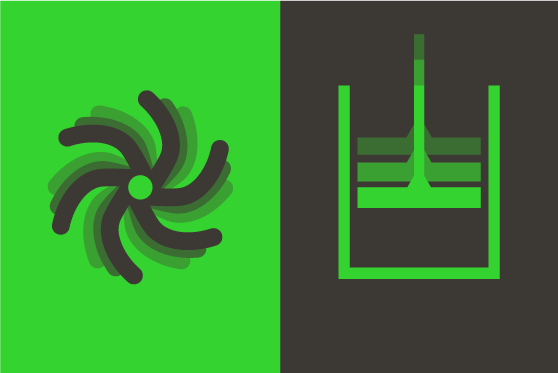There are two main types of pumps available: positive displacement and centrifugal (rotodynamic) pump. It’s important you can distinguish between the two to ensure the pump type selected is appropriate for the application at hand.
Positive displacement pump: the working principle involves an operation that moves fluid by trapping a fixed volume, usually in a cavity, and then forcing that trapped fluid into the discharge pipe.
Centrifugal pump: this involves the transfer of kinetic energy from the motor to the liquid by a spinning impeller. As the impeller rotates it draws in fluid, increasing the velocity which moves the fluid to the discharge point. A centrifugal pump is categorised as a non-positive displacement pump.
 Working principles differ for centrifugal pumps and positive displacement pumps
Working principles differ for centrifugal pumps and positive displacement pumps
Major differences between the two pump types
| Factor |
Centrifugal |
Positive displacement |
| Mechanics |
Impellers pass on velocity from the motor to the liquid which helps move the fluid to the discharge port |
Traps a certain amount of liquid and forces it from the suction to the discharge port. |
| Performance |
The flow rate varies with a change in pressure |
Flow rate remains constant as change in pressure. |
| Viscosity |
The flow rate decreases as the viscosity increases, even moderate thickness, due to frictional losses inside the pump |
The internal clearances allow higher viscosity handling. Flow rate increases with increasing viscosity. |
| Efficiency |
Pump efficiency peaks at a specific pressure - any variations decrease the efficiency dramatically. |
Efficiency is less affected by pressure. Positive displacement pumps can be run at any point on their curve without damage or efficiency loss. |
| Suction lift |
Standard centrifugal pumps cannot create suction lift. |
Positive displacement pumps create a vacuum on the inlet side, making them capable of creating suction lift. |
| Shearing |
The high-speed motor can lead to shearing of liquids - centrifugal pumps are not recommended for shear sensitive mediums. |
The low internal velocity means little shear is applied to the pumped medium - therefore, positive displacement pumps are appropriate for shear-sensitive fluids. |
When should you use a centrifugal pump?
Centrifugal pumps are commonly used to transfer low viscosity fluids in high flow rates, within low pressure installations. They are frequently used when a pump is required to transfer large volumes of media. Centrifugal pumps can be used in a wide variety of applications, including but not limited to:
- general water supply
- sea water transfer
- water circulation
- air conditioning
- light fuel transfer
- petrochemical
- irrigation
- mining
- general industrial and manufacturing
If a vortex impeller is selected, some solids can be handled by a centrifugal pump.
As there are little moving parts in centrifugal pumps, they offer lower maintenance requirements and costs. Therefore, they are suited to applications where the pump is used often, or continuously run. The simple construction ensures there are a wide variety of construction options, including plastics or stainless steel, for more corrosive or hygienic applications.
When should I use a positive displacement pump?
Positive displacement pumps are selected for their ability to handle high viscosity fluids, at high pressure. Although centrifugal pumps are the most common pump installed, positive displacement pumps are a solution that can handle more difficult conditions.
Therefore, two types of positive displacement pumps: rotary and reciprocating.
Rotary positive displacement pumps operate via rotation of a pumping element:
- progressing cavity pumps
- vane pumps
- screw pumps
- peristaltic pumps
- gear pumps
- lobe pumps
Reciprocating positive displacement pumps which operate via a constant back and forth motion:
- diaphragm pumps
- piston pumps
Generally, positive displacement pumps are designed to transfer high viscosity fluids, such as thick oils, slurries, sewage and pastes. Due to their construction, they are also suitable for handling mediums containing high levels of solids, including wastewater and food particles. Screw and vane pumps are ideal for pumping clean fluids, such as fuels and lubrication oils.
As positive displacement pumps are generally lower speed pumps, those with larger pumping chambers, such as progressive cavity, lobe and peristaltic pumps, are typically low shear pumps and provide a smooth flow. This allows shear sensitive products to be pumped effectively and without any changes in composition.
Positive displacement pumps are also capable of handling variations in pressure, flow and viscosity. They can also effectively dose, ensuring accurate metering in every rotation.
Discover the wide range of centrifugal pumps and positive displacement pumps available through Global Pumps here.
Do you want to find out which type of pump is suitable for your application? Not exactly sure which is best? Get in touch with Global Pumps. With over forty years’ experience working in a wide range of industries, we can advise of best practice and ensure an efficient pumping system is selected.

